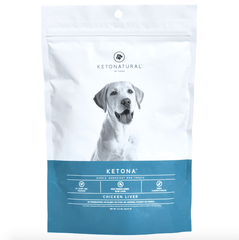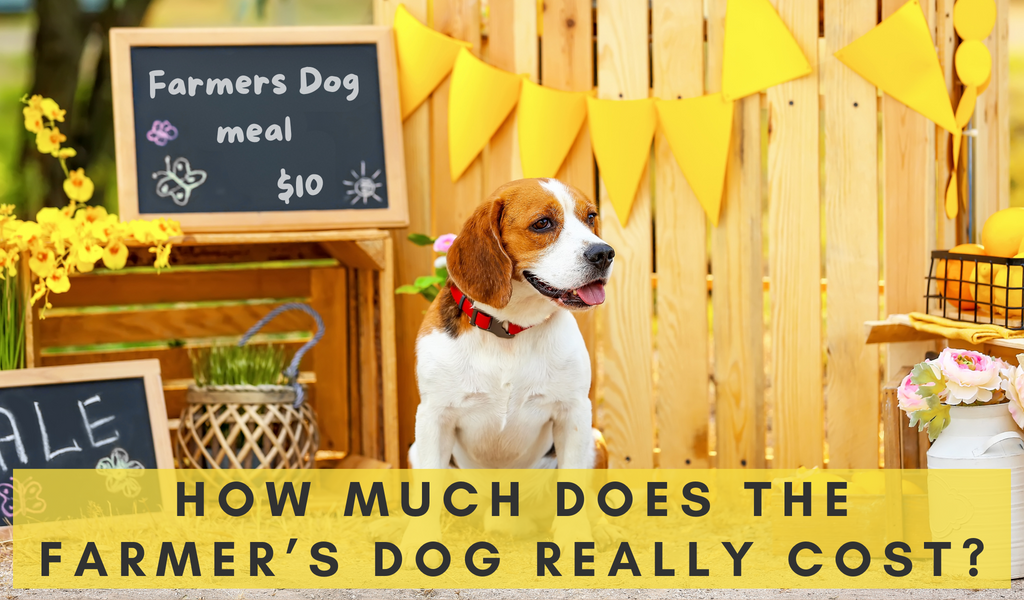Save Money, Save Your Dog.
Join Our Email List For Discounted Pricing and a Free Guide to the Science of Keto Dog Food.
How Much Does The Farmer’s Dog Really Cost?
In our judgment, the Farmer's Dog is one of the most interesting new dog food companies to spring up over the past ten years. You may remember the New York startup from the tearjerker commercial it ran during last year’s Super Bowl.
The company sells what it calls "fresh food" diets. They aren’t raw, they’re cooked. But they also aren’t kibble. In extruded kibbles (like
Ketona), the little nubbins of food are dehydrated after cooking. Whereas products like the Farmer’s Dog food are not – meaning they still contain most of the water present in their ingredients at the end of production. This means that the diets sold by the Farmer’s Dog are typically about 75% water, whereas most extruded kibble products are only about 10%.
This article is one of several that we’re writing about the Farmer’s Dog over the course of this month. Here we are focused on a topic that we get asked about all the time and that usually doesn’t require a long-form article to explain: "Just how much does this stuff cost?”
For most pet food products (and for most consumer products full-stop), you don’t need to be an expert to answer this question. Because most consumer products advertise their prices pretty clearly—after all, a product’s price is a pretty important factor when consumers are deciding whether or not to buy it.
But Farmer’s Dog food is different. For some reason (and we’ll offer a few theories below), the company makes it incredibly difficult to understand how much it will actually cost you. They won’t show you any pricing information whatsoever until you’ve given them your email address and completed a detailed questionnaire about your dog(s). And even then, prices are displayed on a per-day basis, making them hard to compare with other premium dog foods. And (as of July of 2023), they also use a bit of deception and misdirection in order to make their prices appear somewhat lower than they are in reality.
Take all this together and you can see why dog owners find it so difficult to determine the cost of the Farmer’s Dog. According to Google, about 25,000 consumers ask the search engine "How much does the Farmer’s Dog cost?” every month. That’s about 25 times as many people as are asking the same question about Orijen, Blue Buffalo, and Natural Balance combined. And each of those three brands is at least dozens of times larger than the Farmer’s Dog. So clearly something’s up.
Fortunately, we’re here to help. In this post, we’ll explain everything you need to know about how much the Farmer’s Dog costs. We’ll tell you the raw numbers behind what it costs to feed your dog, make some comparisons to other popular products, and (because as you’ll see, the prices for Farmer's Dog recipes are pretty darn high) explain why it costs so much in the first place.
Let’s get down to business.
How Much is Farmer’s Dog Fresh Dog Food?
The price of the Farmer’s Dog food for a 50-pound adult dog is $7.25 to $8.00 per day, depending on which of the four protein options (turkey, beef, chicken, or pork) you choose.
Naturally, the price for a smaller dog is somewhat less. The cost for a 20-pound dog is $4.44 to $4.87 per day, depending on which protein you choose.
And, if (like me) you have large dogs or giant-sized breeds, the price goes up by quite a lot. Wayne, my Saint Bernard, weighs about 160 pounds. Feeding him the Farmer’s Dog would set me back $16 to $18 per day.
Now, a few notes and comments about this information.
First, all of these prices assume that your dog gets very little daily exercise. If your dog gets daily walks or trips to the dog park he’ll need more calories per day (and thus more food) to maintain caloric balance. Which means even higher prices. Owners who give their dogs daily jogs should expect to pay 30% to 40% more than the prices above.
Second, if you complete the Farmer’s Dog intake questionnaire and find yourself staring at a somewhat lower price than what you see above, make sure you’re reading the right information. The company offers new customers a 50% (or even 60%) discount on their first order. Which is great. But the way they present their pricing information makes it very easy to think that 50% discount applies to all orders. And that’s something quite different. Here’s what I mean:

Wow, only $8.66 per day!

Or wait. Huh?
Confusing, right? The bottom line is you get a 50% discount on your first week. After that, the prices from the beginning of this section of the article kick in.
Farmer’s Dog Cost Compared to Other Dog Foods
Now that we’ve helped you understand how much it costs to feed your dog the Farmer’s Dog diet in pure dollars and cents terms, we also want to explain how its price compares to some other popular pet foods products.
This is a vital part of the exercise because most pet food products aren’t priced by the day or week. They’re priced by the bag. So without doing an apples-to-apples comparison it can be very difficult to understand how switching to the Farmer’s Dog will change your actual spending habits.
To provide you with an apples-to-apples comparison, I’ve chosen four different kibbles and used their feeding instructions, prices on Chewy.com as of July 2023, and label information to calculate a daily cost for each one. For ease of comparison, I’ve used a 50-pound adult dog in all cases.
Here’s what I found:
Ketona Chicken Recipe Dog Food:
$2.60 per day for a 50-pound adult dog
Orijen Original Dog Food:
$1.99 per day for a 50-pound adult dog
Purina Pro Plan Shredded Chicken and Rice:
$1.26 per day for a 50-pound adult dog
Blue Buffalo Wilderness Chicken:
$2.08 per day for a 50-pound adult dog
Farmer’s Dog:
$7.25 per day for a 50-pound adult dog
So, to summarize, all kibbles cost way less than the Farmer’s Dog. More specifically, the Farmer’s Dog will cost you five to six times as much as what you might charitably call “premium” kibbles (like Purina Pro Plan) and the farmer's dog cost you three to four times as much as higher-protein “ultra-premium” options like Orijen and Ketona.
Obviously those are huge differences. But to truly understand how large they are it’s helpful to think about them in terms of annual expenditures too. The owner of a 50-pound dog will spend $500 to $1,000 per year if they feed their dog kibble. Whereas that same owner would spend somewhere between $2600 and $3000 on the Farmer’s Dog.
So that’s a couple of extra thousand dollars each year for the Farmer’s Dog.
That’s a lot of chew toys....
Why is the Farmer’s Dog So Expensive?
Naturally, if you are going to feed your dog the most expensive dog food in the history of the pet food industry, you have every right to expect a pretty special product.
So is the Farmer’s Dog worth it? Perhaps not in the way you think.
We’re going to analyze the Farmer’s Dog from a health and nutrition perspective in a separate article. That subject involves a good deal of nuance and requires some discussion of scientific topics too, so it’s a bit much to try to pack it all in here.
But this is probably the right place to discuss a few other unique things about the product that also clearly play a role in making it so expensive.
The first is the type of facility in which it is prepared. The Farmer’s Dog calls a lot of attention to the fact that all of its diets use “human grade ingredients” This label is a way of saying that the diets are prepared in a plant that meets a different (and generally more rigorous) safety standard than the one most pet food plants use. The vast majority of commercial pet foods and pet food ingredients are produced in facilities that don’t have to meet the USDA’s standards for human-consumption food products. Which is why mandatory pet food recalls, while very uncommon, are certainly more common than recalls of human-consumption foods like coffee and breakfast cereal.
As you’d expect, it is more expensive for a manufacturer to comply with the USDA’s human-grade factory standards for fresh meals than it is to meet the less rigorous standards otherwise used with pet foods and livestock feed products. And that’s certainly one of the reasons why the Farmer’s Dog costs so much. (Whether the added costs justify decreasing the risk of contamination from one in a hundred million meals to one in a billion meals, or whatever, is another matter altogether.)
The second reason the Farmer’s Dog likely costs so much has to do with the kind of foods it sells. The company calls its diets “fresh.” To my eyes, that’s not a particularly accurate way to describe the products because neither of the two most common qualities of fresh foods (being raw/uncooked and never being frozen) apply to the Farmer’s Dog—its diets are both cooked and frozen.
Instead, what the company seems to mean by “fresh” is “not dehydrated.” As mentioned earlier, while extruded kibbles only contain about 10% water, the Farmer’s Dog is more than 75% water. And shipping all that water around the country costs the company a fortune. Two separate things account for the additional cost. The first is that water-laden products are simply a lot heavier. Because of all the extra water, each calorie of the Farmer’s Dog weighs much, much more than every calorie of kibble. And moving all that extra weight around the country is very expensive, particularly when you are shipping individual orders (as the Farmer’s Dog does), as opposed to truckloads.
The second reason why fresh (read: “wet”) diets are so expensive is they spoil much more quickly than dry ones do. Bacteria and other pathogens thrive in water. Which is why raw meats and fresh vegetables need to be refrigerated while dry goods like cereals, raisins, and protein powders are shelf stable. Accordingly, the Farmer’s Dog needs to keep its foods frozen or refrigerated from the time they are manufactured right up until they get consumed. It’s either that or the products will spoil. And, in addition to being inconvenient for consumers (with refrigerators or freezers full of dog food), that obviously costs the Farmer’s Dog quite a lot too.
So those are at least two of the main reasons why the Farmer’s Dog is so pricey. But what about its nutritional value? If it’s going to cost seven or eight times as much as ordinary kibble it would be fair to assume that it’s a much healthier choice for your dog's diet.
So is it? Is the Farmer’s Dog actually better for your dog's health?
Stay tuned, we’ll tackle that interesting subject in our next article....


Browse Articles By Category